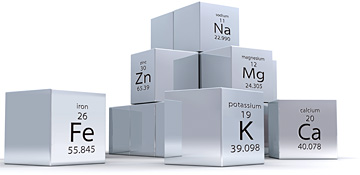There's no doubt that the absorption and storage of too many heavy metals such as mercury, cadmium, lead and others is unsafe. Other metals or minerals such as beryllium, copper, fluorine, nickel, silver and aluminum also raise red flags.
Unfortunately, the result of all this negative hype can be an obsession about avoiding metals in any form.
Getting Minerals in Their Ideal Form
What many do not realize is that it's not necessarily the metal itself that is the problem. Rather, it is the form that determines whether a mineral is harmful or beneficial. What is important to know is that the previously mentioned minerals, along with other trace minerals, are actually absolutely essential for proper health. In fact, we cannot survive without them.
This is a good time to discuss the distinction between organic trace minerals and metallic minerals, as well as the importance of quantities. Essential trace elements are "essential" only when used in trace amounts. When used in excess, they can become toxic. However, it is also important to understand that consumption of plant-derived mineral fulvic complexes, which will be discussed shortly, will not build up in the body tissues as do metallic minerals.
 A good example of the difference between organic trace minerals and metallic minerals is the metal aluminum. Aluminum makes up 12 percent of the Earth's crust and is the most abundant metallic element. Even though there are arguments that a large amount of aluminum in the body may be responsible for cognitive disorders such as dementia and Alzheimer's disease, it's rare that these same arguments mention the form or benefits of aluminum.
A good example of the difference between organic trace minerals and metallic minerals is the metal aluminum. Aluminum makes up 12 percent of the Earth's crust and is the most abundant metallic element. Even though there are arguments that a large amount of aluminum in the body may be responsible for cognitive disorders such as dementia and Alzheimer's disease, it's rare that these same arguments mention the form or benefits of aluminum.
Aluminum is a major component in all soils and enters the food chain at every level, be it plant or animal, and is beneficial for health. If natural compounds of organic aluminum were toxic or hazardous to humans, life as we know it would cease. The known biological function, and thus benefit, of aluminum is to activate an enzyme called succinic dehydrogenase. This enzyme increases survival rates of newborn infants and, according to Dr. Gerhard Schrauzer, professor emeritus (department of chemistry) at the University of California San Diego, is an essential mineral for human nutrition. Even arsenic, in trace levels, is an essential element for optimal health and longevity, suggests research.
Fulvic Acid: Key for Mineral Utilization
No discussion of minerals would be complete without including a vital aspect of mineral utilization: fulvic acid. Fulvic acid is one of two classes of a natural acidic organic polymer that can be extracted from humus (the healthy result of decaying organic matter), soil, sediment or aquatic environments. Fulvic acid is believed to originate as a product of microbial metabolism.
Because minerals are absorbed through the soil into plant material that both man and animals consume, fulvic acid is absolutely essential for the assimilation of minerals into a small enough form to be completely dissolved and used by the body. Fulvic acid is so powerful thata single molecule is capable of carrying60 or more minerals and trace elements into the cells. Unfortunately, the humus deposits rich with fulvic acid have been missing from our diets for decades. They are quite rare in this generation and can only be found in very limited areas of the world.

